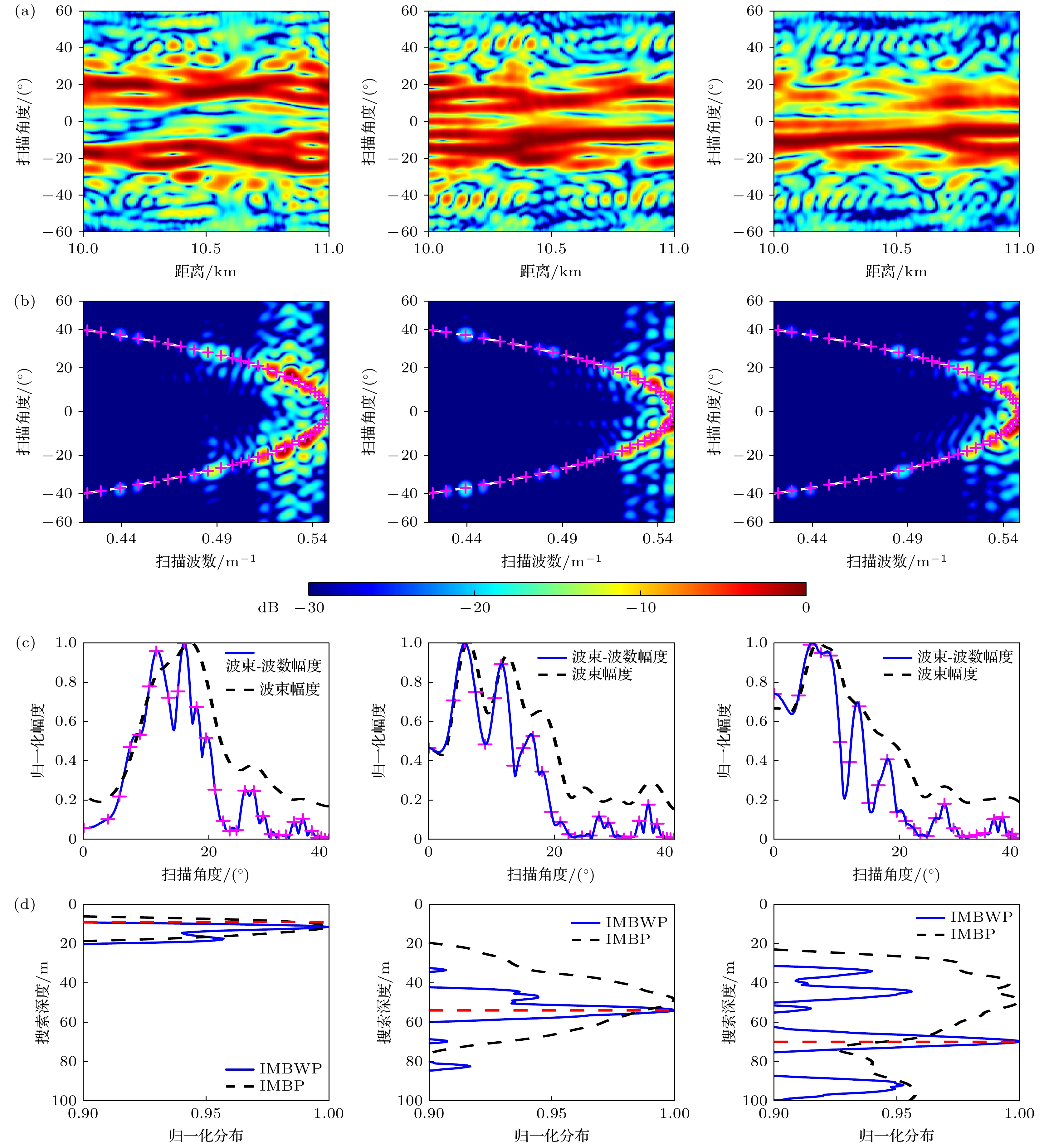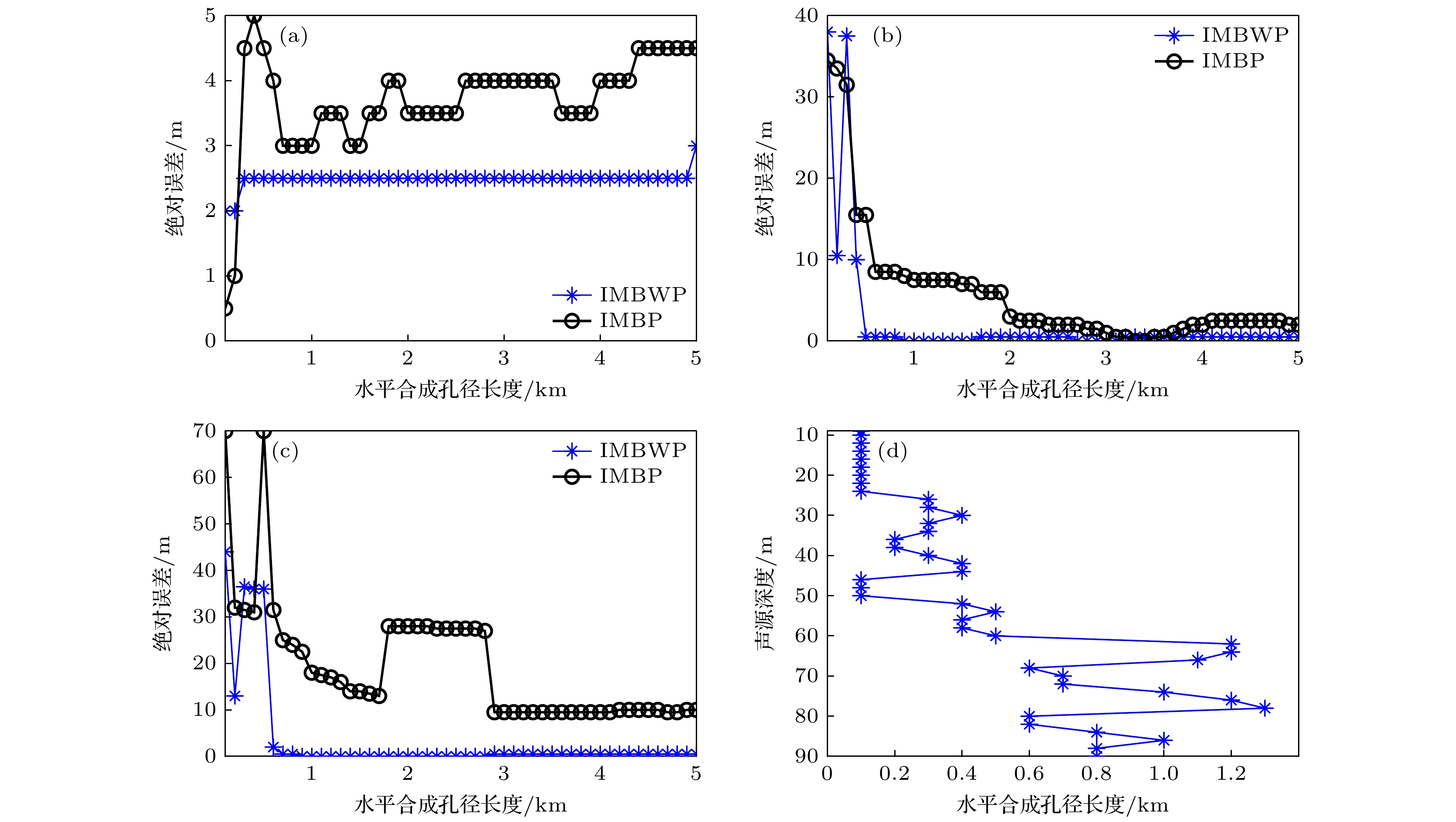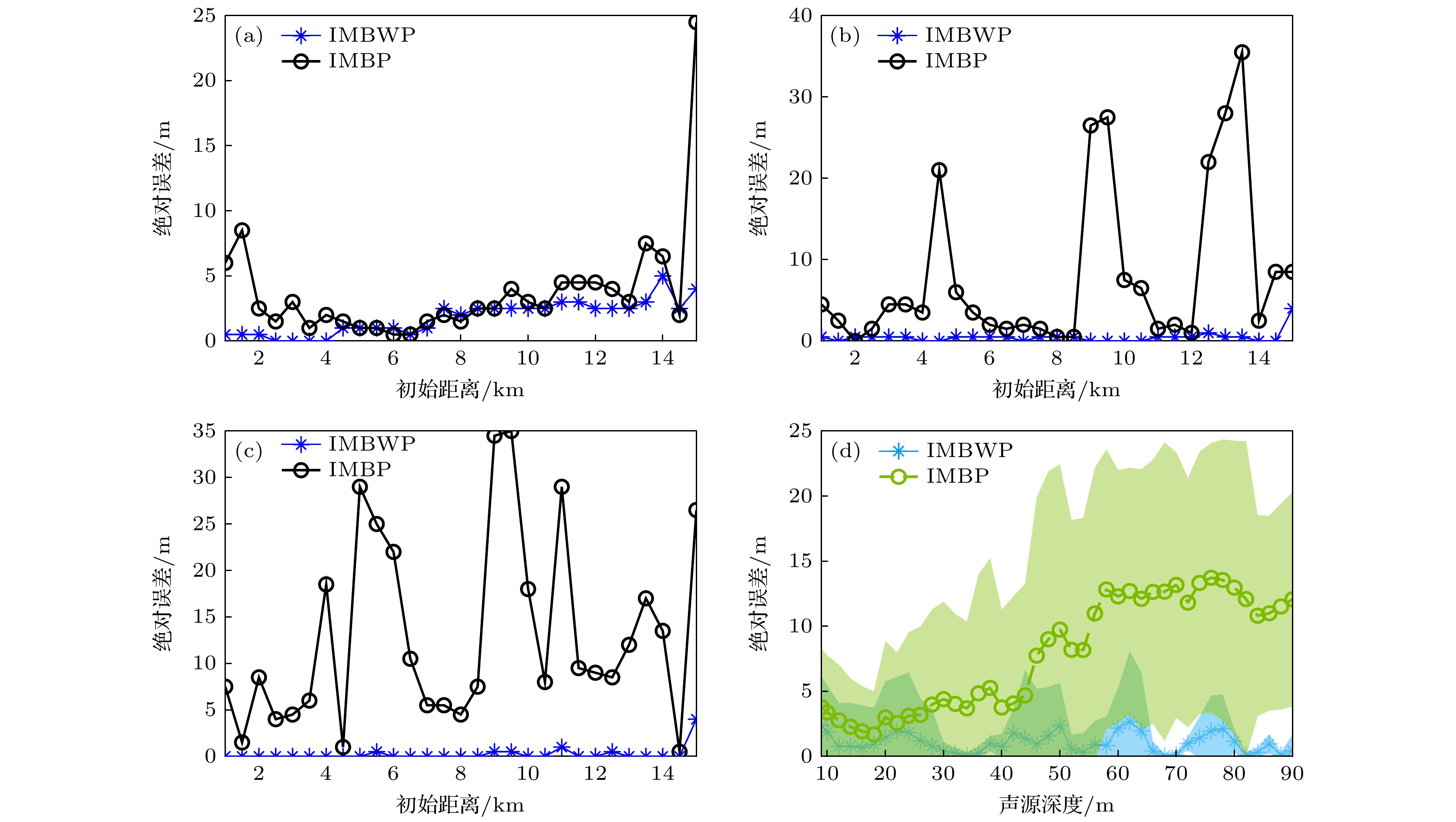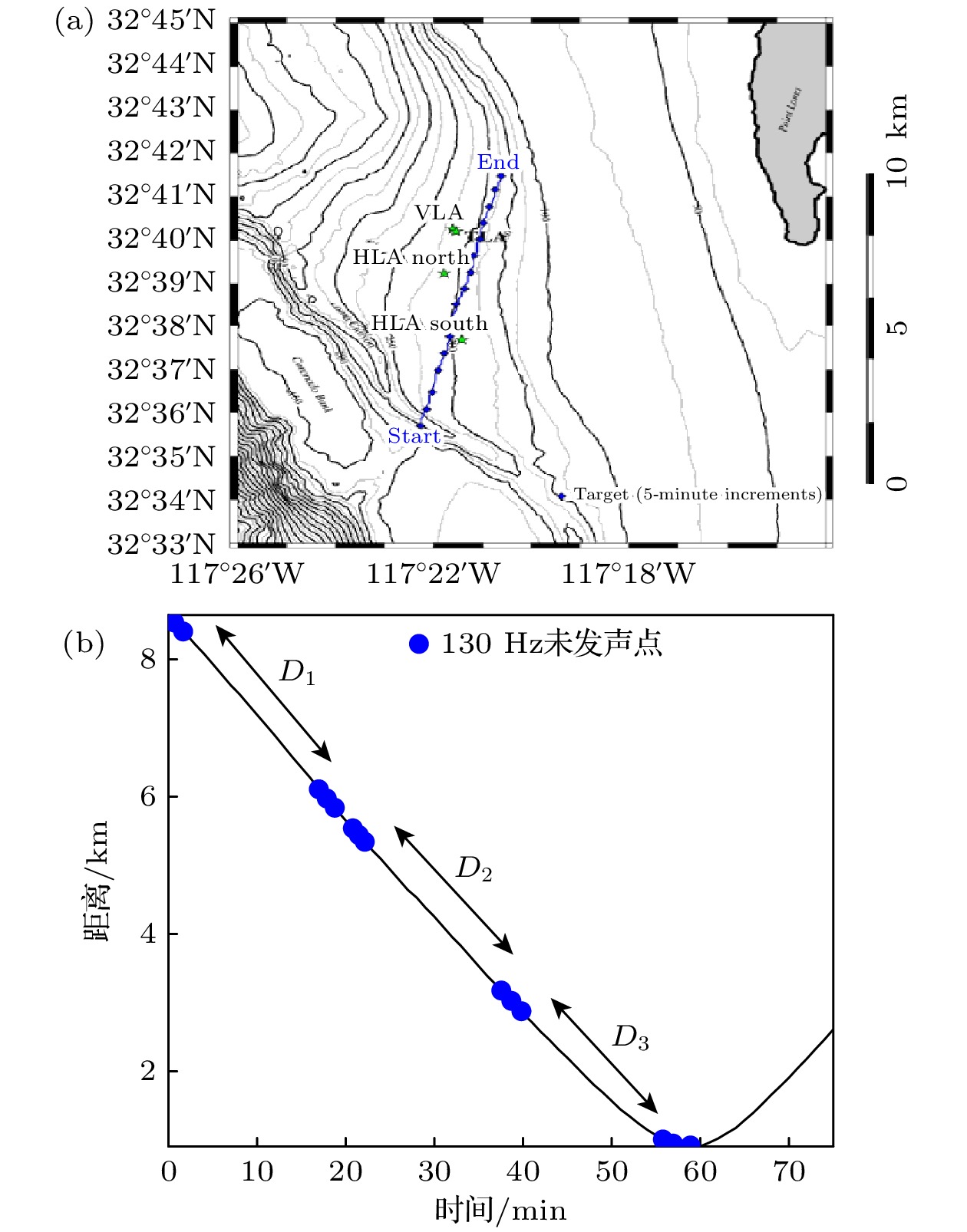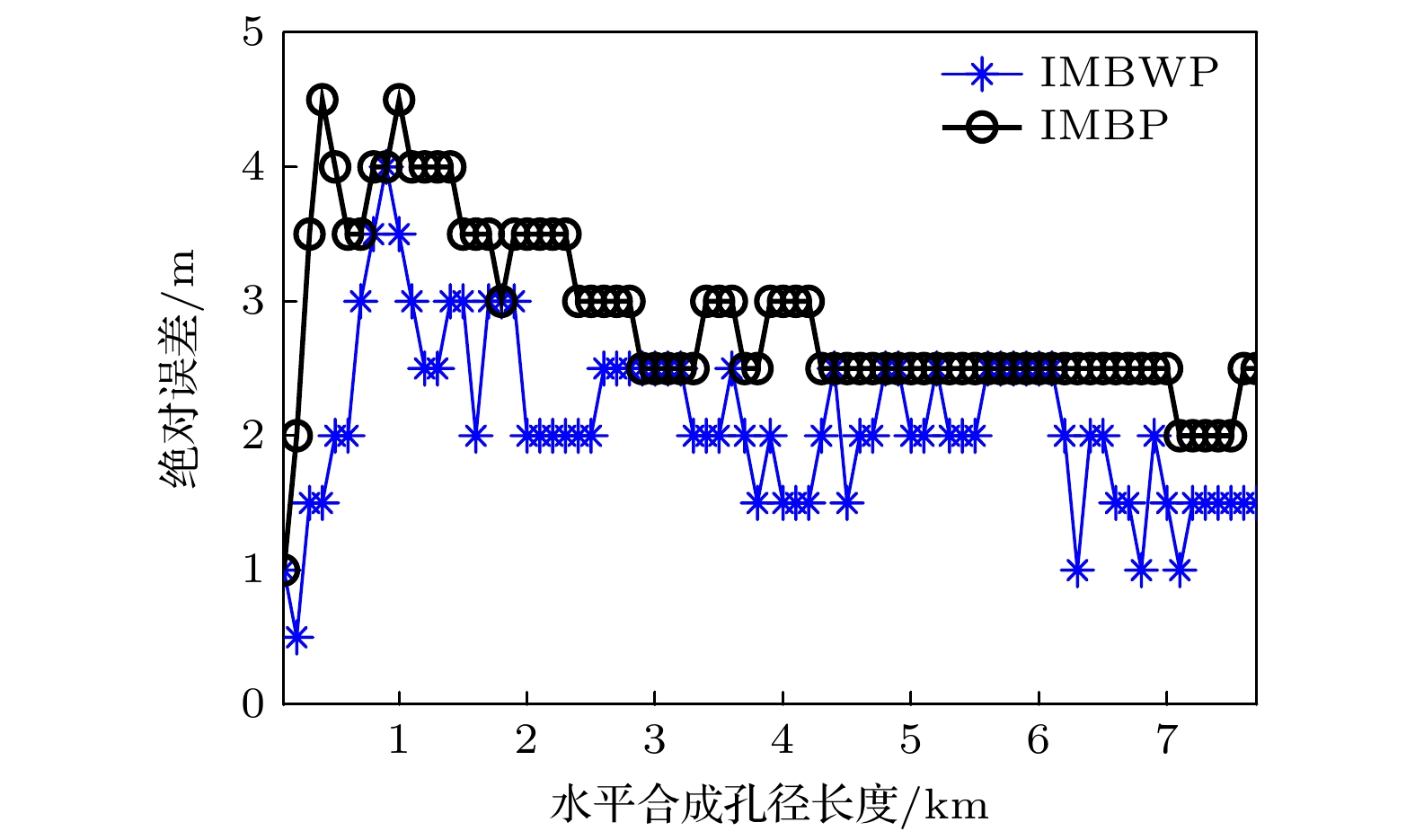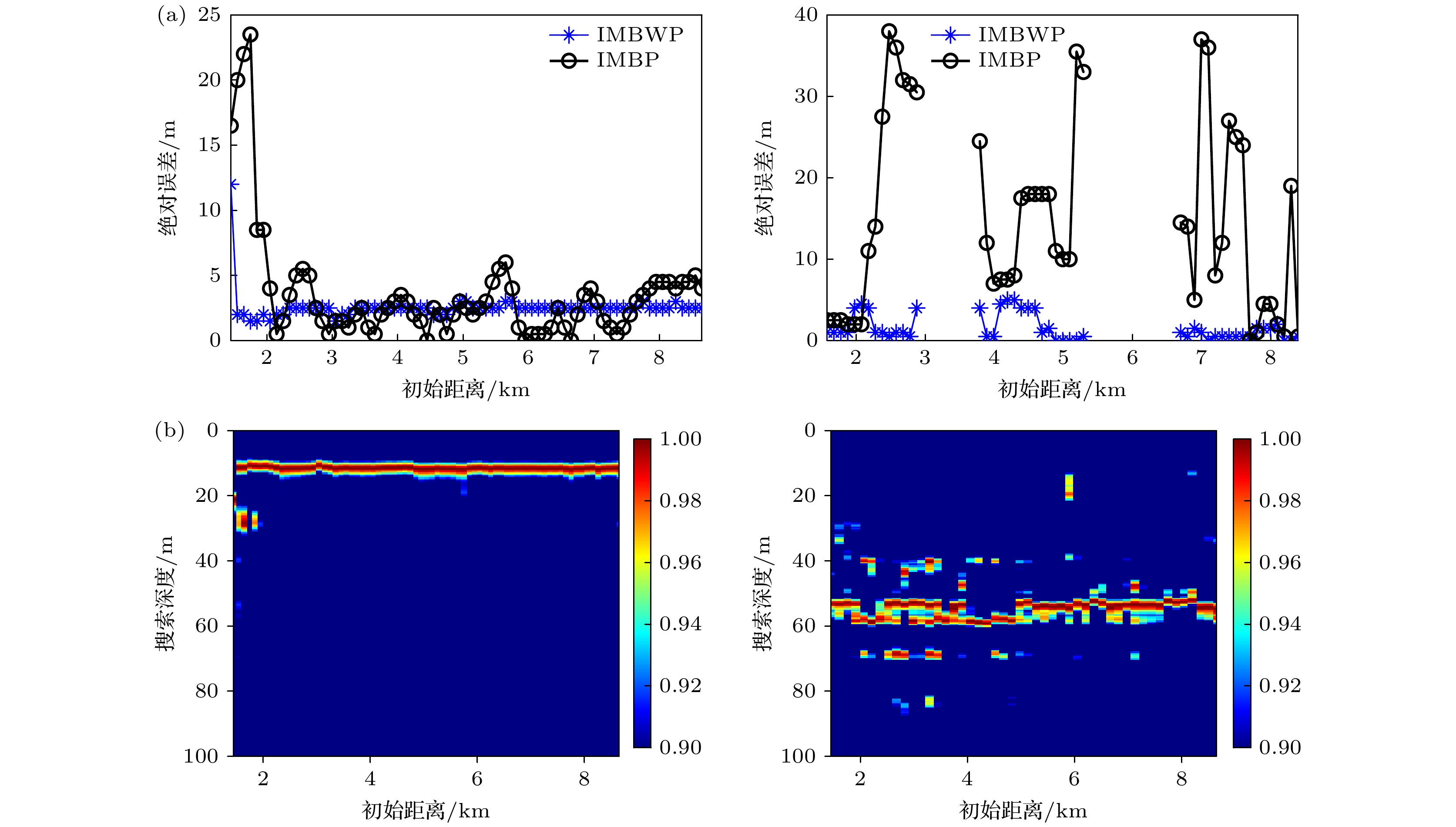-
Estimating the depth of a moving source with unknown source range is always a challenging problem in shallow water waveguides. The method of estimating the current motion source depth is sensitive to the unknown initial range and requires the horizontal synthetic aperture length formed by the motion of the source to be much longer than the modal interference period. Presented in this work is a method to estimate the depth of moving source based on the incoherently matched beam-wavenumber. In the beam-wavenumber domain, each peak amplitude only contains the modal excitation related to source depth, and each peak position corresponds to the mode propagation angle and the horizontal wavenumber. In this method, the received data are first used to perform beam-formed transformation in the vertical depth and horizontal synthetic aperture direction, and transformed into the beam-wavenumber domain. Then beam-wavenumber peak amplitudes are extracted and incoherently matched with the modal depth function to estimate the source depth. The proposed method is used to eliminate the unknown distance dependent term and improves the mode resolution by performing mode separation in the beam-wavenumber two-dimensional domain. The prominent feature of this method lies in realizing the source depth estimation at the unknown initial range and the horizontal synthetic aperture length which is smaller than the mode interference period. The simulation and SWellEx-96 experimental data processing results validate the superior performance of the proposed method.
-
Keywords:
- shallow water waveguide /
- moving source /
- depth estimation /
- beam-wavenumber domain
[1] Premus V E 1998 J. Acoust. Soc. Am. 104 1837
[2] Premus V E, Helfrick M N 2013 J. Acoust. Soc. Am. 133 4019
 Google Scholar
Google Scholar
[3] Conan E, Bonnel J, Chaonavel T 2016 J. Acoust. Soc. Am. 140 434
 Google Scholar
Google Scholar
[4] Conan E, Bonnel J, Nicolas B 2017 J. Acoust. Soc. Am. 142 2776
 Google Scholar
Google Scholar
[5] 曹怀刚, 赵振东, 郭圣明, 马力 2020 声学学报 6 802
Cao H G, Zhao Z D, Ma L 2020 Acta. Acustica. 6 802
[6] 刘志韬, 郭良浩, 闫超 2019 声学学报 44 28
Liu Z T, Guo L H, Yan C 2019 Acta. Acustica. 44 28
[7] Bucker H P 1976 J. Acoust. Soc. Am. 59 368
 Google Scholar
Google Scholar
[8] Yang T C 1990 J. Acoust. Soc. Am. 87 2072
 Google Scholar
Google Scholar
[9] Shang E C 1985 J. Acoust. Soc. Am. 77 1413
 Google Scholar
Google Scholar
[10] Yang T C 1987 J. Acoust. Soc. Am. 82 1736
 Google Scholar
Google Scholar
[11] Yang T C, Bogart C W 1994 J. Acoust. Soc. Am. 96 1677
 Google Scholar
Google Scholar
[12] Lopatka M, Touzé G L, Nicolas B, Cristol L 2006 Eurasip J. Adv. Sig. Pr. 65901
[13] 李焜, 方世良, 安良 2013 62 094303
 Google Scholar
Google Scholar
Li K, Fang S L, An L 2013 Acta. Phys. Sin. 62 094303
 Google Scholar
Google Scholar
[14] Reeder B D 2014 J. Acoust. Soc. Am. 136 2120
[15] Yang T C 2015 J. Acoust. Soc. Am. 137 2986
 Google Scholar
Google Scholar
[16] Yang T C, Xu W 2016 J. Acoust. Soc. Am. 140 EL302
 Google Scholar
Google Scholar
[17] Zhang J G, Yang T C, Zheng G Y 2021 J. Acoust. Soc. Am. 1 EL 026002
[18] Jensen F B, Kuperman W A, Porter M B, Schmidt H 2011 Computational Ocean Acoustics (New York: Springer) pp629–630, 355, 359
[19] Katsnelson B, Petnikov V, Lynch J 2012 Fundamentals of Shallow Water Acoustics (Boston: Springer) p86
[20] Murray J, Ensberg D The SWellEx-96 Experiment http://swellex96.ucsd.edu/ (Last viewed December 2022)
[21] Porter M B 1992 The KRAKEN Normal Mode Program (Washington DC: Naval Research Laboratory)
-
图 4 9, 54和70 m声源深度下的仿真结果 (a) 10—11 km的波束输出; (b) 波束-波数输出; (c) 归一化的波束幅度和波束-波数幅度对比; (d) IMBWP和IMBP方法的归一化深度模糊函数对比
Figure 4. Simulation results at 9, 54 and 70 m source depths: (a) Beam output from 10 km to 11 km; (c) beam-wavenumber output; (c) normalized beam amplitude and beam-to-wavenumber amplitude comparison; (d) normalized ambiguity functions comparison between IMBWP and IMBP methods.
图 5 不同水平合成孔径长度下IMBWP方法对54 m声源的仿真结果对比(a), (b) 0.25 km和2.5 km水平合成孔径长度下的波束-波数输出; (c) 归一化深度模糊函数
Figure 5. Comparison of simulated data by IMBWP method at different synthetic aperture lengths: (a), (b) Beam-wavenumber outputs at 0.25 km and 2.5 km synthetic aperture lengths, respectively; (c) normalized depth ambiguity function.
图 6 不同水平合成孔径长度下IMBWP和IMBP方法的深度估计绝对误差仿真结果对比(a)—(c) 9, 54和70 m声源; (d) IMBWP估计10—90 m声源所需最小水平合成孔径长度
Figure 6. Comparison of depth estimation absolute error for simulated data by IMBWP and IMBP methods at different synthetic aperture length: (a)–(c) 9, 54 and 70 m source; (d) IMBWP method estimates the minimum synthetic aperture length required for 10–90 m sources.
图 7 不同初始距离下IMBWP和IMBP方法的深度估计绝对误差仿真结果对比(a)—(c) 9, 54和70 m声源; (d) 10—90 m声源在500个随机初始距离处的深度估计绝对误差均值和标准差
Figure 7. Comparison of depth estimation absolute error for simulated data by IMBWP and IMBP methods at different initial ranges: (a)–(c) 9, 54 and 70 m source; (d) mean and standard deviation of depth estimation absolute errors for 10–90 m sources at 500 random initial ranges.
图 10 不同水平合成孔径长度下IMBWP和IMBP方法对54 m声源实验数据的深度估计结果 (a)—(c) D1, D2和D3数据段; (d) D1—D3数据段深度估计的平均绝对误差
Figure 10. Depth estimation of experimental data for the 54 m source by IMBWP and IMBP methods at different synthetic aperture length: (a)–(c) D1, D2 and D3 data segment; (d) depth estimation average absolute errors of D1– D3 data segments.
图 11 不同初始距离下9 m和54 m声源实验数据的深度估计结果 (a) IMBWP和IMBP方法的深度估计绝对误差对比; (b) IMBWP方法的归一化深度模糊函数伪彩图
Figure 11. Depth estimation of experimental data for 9 m and 54 m sources at different initial ranges: (a) Comparison of depth estimation absolute errors between IMBWP and IMBP method; (b) normalized depth ambiguity surface of IMBWP method.
表 1 D1—D3数据段对应时间和距离
Table 1. The time and range of D1–D3 data segments.
数据段 时间/min 距离/km D1 1.7—18.2 8.4—6.2 D2 22.4—36.4 5.3—3.3 D3 39.7—57.4 3.2—1.5 -
[1] Premus V E 1998 J. Acoust. Soc. Am. 104 1837
[2] Premus V E, Helfrick M N 2013 J. Acoust. Soc. Am. 133 4019
 Google Scholar
Google Scholar
[3] Conan E, Bonnel J, Chaonavel T 2016 J. Acoust. Soc. Am. 140 434
 Google Scholar
Google Scholar
[4] Conan E, Bonnel J, Nicolas B 2017 J. Acoust. Soc. Am. 142 2776
 Google Scholar
Google Scholar
[5] 曹怀刚, 赵振东, 郭圣明, 马力 2020 声学学报 6 802
Cao H G, Zhao Z D, Ma L 2020 Acta. Acustica. 6 802
[6] 刘志韬, 郭良浩, 闫超 2019 声学学报 44 28
Liu Z T, Guo L H, Yan C 2019 Acta. Acustica. 44 28
[7] Bucker H P 1976 J. Acoust. Soc. Am. 59 368
 Google Scholar
Google Scholar
[8] Yang T C 1990 J. Acoust. Soc. Am. 87 2072
 Google Scholar
Google Scholar
[9] Shang E C 1985 J. Acoust. Soc. Am. 77 1413
 Google Scholar
Google Scholar
[10] Yang T C 1987 J. Acoust. Soc. Am. 82 1736
 Google Scholar
Google Scholar
[11] Yang T C, Bogart C W 1994 J. Acoust. Soc. Am. 96 1677
 Google Scholar
Google Scholar
[12] Lopatka M, Touzé G L, Nicolas B, Cristol L 2006 Eurasip J. Adv. Sig. Pr. 65901
[13] 李焜, 方世良, 安良 2013 62 094303
 Google Scholar
Google Scholar
Li K, Fang S L, An L 2013 Acta. Phys. Sin. 62 094303
 Google Scholar
Google Scholar
[14] Reeder B D 2014 J. Acoust. Soc. Am. 136 2120
[15] Yang T C 2015 J. Acoust. Soc. Am. 137 2986
 Google Scholar
Google Scholar
[16] Yang T C, Xu W 2016 J. Acoust. Soc. Am. 140 EL302
 Google Scholar
Google Scholar
[17] Zhang J G, Yang T C, Zheng G Y 2021 J. Acoust. Soc. Am. 1 EL 026002
[18] Jensen F B, Kuperman W A, Porter M B, Schmidt H 2011 Computational Ocean Acoustics (New York: Springer) pp629–630, 355, 359
[19] Katsnelson B, Petnikov V, Lynch J 2012 Fundamentals of Shallow Water Acoustics (Boston: Springer) p86
[20] Murray J, Ensberg D The SWellEx-96 Experiment http://swellex96.ucsd.edu/ (Last viewed December 2022)
[21] Porter M B 1992 The KRAKEN Normal Mode Program (Washington DC: Naval Research Laboratory)
Catalog
Metrics
- Abstract views: 5180
- PDF Downloads: 158
- Cited By: 0















 DownLoad:
DownLoad:


